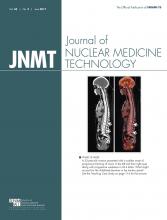REPLY: We thank Dr. Naganawa for his interest in our article, in which we present the findings from our pilot study investigating 18F-FDG uptake in the brain after repeated gadolinium-based contrast agent administration (1). In our retrospective analysis, patients who had previously undergone 3–6 contrast-enhanced MRI studies demonstrated significantly decreased uptake in the dentate nucleus and globus pallidus on 18F-FDG PET/CT (measured as decreased median SUVmax) compared with patients with no history of gadolinium-based contrast agent administration. Given the strong emerging interest in the focus of this study and the potential impact of our early findings, we read Dr. Naganawa’s comments with great interest.
In principle, we agree with the three points Dr. Naganawa raised. Patients in the subject group underwent whole-body PET/CT as part of an oncologic workup, whereas those in the control group received a dedicated brain PET/CT study as part of a traumatic brain injury protocol. We agree that this difference in imaging protocol could have been a confounding factor in the evaluation of 18F-FDG uptake and SUVmax calculation; however, since this pilot study was retrospective, we were restricted to using those available patients whose clinical and imaging histories met our criteria. The study design was also the main cause for the difference in age between the two groups (36 vs. 54 y). This too could have been a source of confounding, although we did perform an additional analysis to determine whether an interaction effect from age was present and found no effect in our small sample sizes. Finally, we agree that the differences in patient disease status could have been an issue. The patients in the control group had clinical histories for which at least one unenhanced brain MRI study was indicated, whereas those in the subject group had indications for multiple contrast-enhanced MRI studies, of which at least two were brain studies. Although these patients may have had a variety of issues that warranted their MRI studies, we did exclude any patients with known brain lesions or prior brain irradiation that may have affected 18F-FDG distribution and uptake patterns.
Although the initial findings from our pilot study were exciting, we agree that more research is needed for validation. In an ideal situation, a prospective study design would be used that would account for many of these issues that were raised. Participants with no history of gadolinium-based contrast agent administration would receive a baseline PET/CT study, followed by one or more contrast-enhanced MRI studies, and finally a follow-up PET/CT study for comparison. Rather than having separate groups that were controlled for demographics and clinical status, each participant would be self-matched and therefore serve as his or her own control. The time and resources needed to conduct such a study would be greater, but it would provide a more rigorous validation of our findings.
Footnotes
Published online Mar. 9, 2017.







